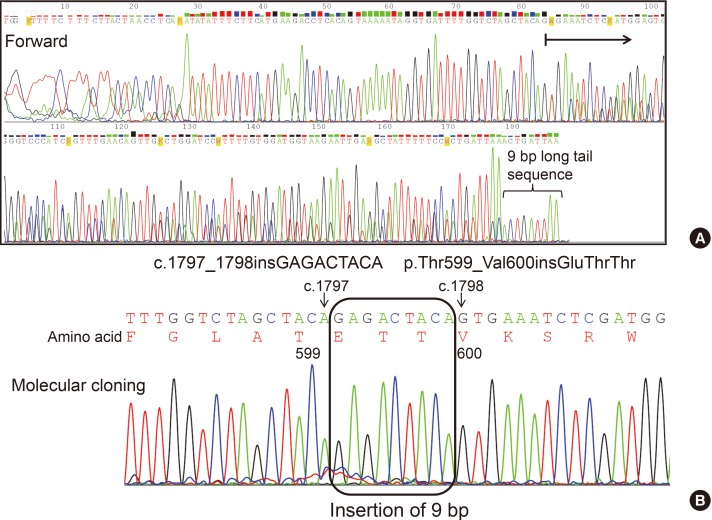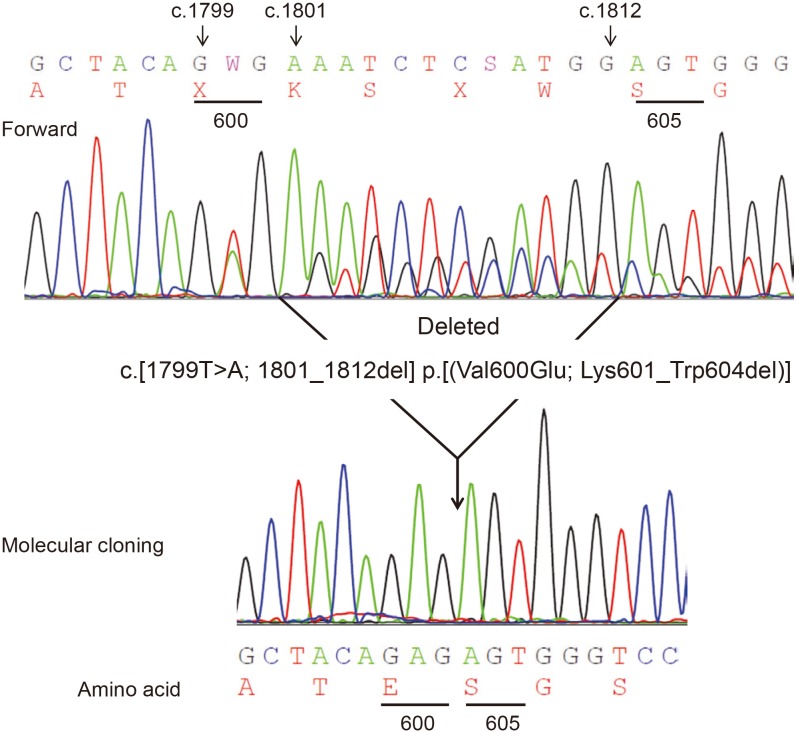Abstract
The most common BRAF mutation in thyroid cancer is c.1799T>A (p.Val600Glu), and other BRAF mutations are rarely reported. We investigated the clinicopathological features of thyroid cancer with rare BRAF mutations. A total of 2,763 patients with thyroid cancer underwent molecular testing by direct DNA sequencing for mutations in BRAF exon 15. Among them, 2,110 (76.4%) had BRAF mutations. The c.1799T>A mutation was found in 2,093 (76.9%) of 2,722 papillary carcinomas and in one of 7 medullary carcinomas. Sixteen cases (0.76%) harbored rare mutation types. Five cases had single-nucleotide substitutions, 5 cases had small in-frame deletion or insertion, and one harbored a two-nucleotide substitution. Of these mutations, 2 were novel (c.1797_1798insGAGACTACA, c.[1799T>A; 1801_1812del]). The c.1801A>C mutation was identified in 4 follicular variant papillary carcinomas and one follicular carcinoma. None of the patients with the c.1801A>C mutation showed extrathyroidal extension or lymph node metastasis. The prevalence of rare BRAF mutations was 0.76% of all BRAF-positive thyroid cancers, and the rare mutations were associated with less aggressive pathologic features. Although BRAF mutations are detected exclusively in papillary carcinoma, they are also found in medullary carcinoma and follicular carcinoma.
Graphical Abstract
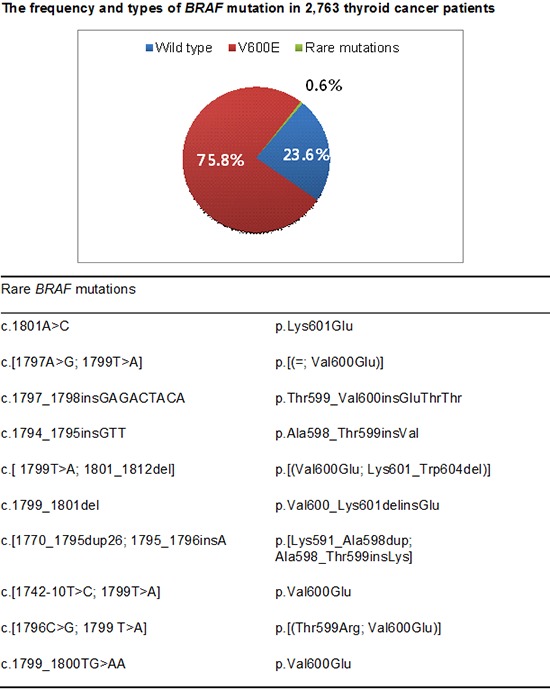
Keywords: Thyroid Neoplasms, BRAF, Mutation, Pathology, Biomarkers
INTRODUCTION
Mutations in the BRAF gene are the most common genetic alteration in papillary thyroid carcinomas (PTC) and are present in 30%-87% of these carcinomas in different populations (1). The spectrum of mutations in this gene includes point mutations, small "in-frame" deletions or insertions, and chromosomal rearrangements. Among those, the most common mutation is a point mutation that involves a thymine to adenine substitution at position c.1799 of the BRAF gene, which results in a valine-to-glutamate substitution at amino acid codon 600 (p.Val600Glu; V600E). BRAF V600E represents almost 99% of all BRAF mutations in thyroid cancer (2). We previously reported that BRAF mutations were found in 835 (80.2%) of 1,041 Korean patients with PTC (2). Most PTCs with the BRAF V600E mutation showed papillary growth pattern, either classic or tall cell variants (3, 4). The second most common mutation was a single nucleotide substitution of adenine to guanine at position 1801 (c.1801A>C), which leads to lysine to glutamate substitution at residue 601 (p.Lys601Glu; K601E). BRAF K601E has been reported in about 1% of PTCs, especially the follicular variant of PTC (FVPTC), and in 2 cases of follicular adenoma (3, 5). Other BRAF point mutants are very rare in thyroid cancers.
We investigated the type and prevalence of rare BRAF mutations and their clinicopathologic characteristics in a large number of thyroid cancer cases. Furthermore, we report novel complex mutations of the BRAF gene that were identified in PTC.
MATERIALS AND METHODS
Patients
A total of 2,763 consecutive patients with thyroid cancers who had surgery at Seoul St. Mary's Hospital between October 2008 and June 2013 were retrospectively reviewed including the 1,041 PTC patients used in our previous study (2). Thyroid cancer slides were reviewed by an endocrine pathologist and classified according to the World Health Organization classification.
Genomic DNA was extracted from two 10-µm sections of formalin-fixed, paraffin-embedded archival tissue blocks. The representative tumor areas were marked and manually microdissected under a stereomicroscope. The largest tumors were chosen for the study from cases with multifocal lesions. After deparaffinization, genomic DNA was extracted using the QIAamp DNA Mini Kit (Qiagen, Hilden, Germany) according to manufacturer's instructions.
A 224-bp fragment of exon 15 of the BRAF gene was amplified using polymerase chain reaction (PCR) with the following primers: forward (5'-TCATAATGCTTGCTCTGATAGGA-3') and reverse (5'-GGCCAAAAATTTAATCAGTGGA-3'). Thermo cycling was performed as follows: 35 cycles at 94℃ for 30 sec, 55℃ for 30 sec and 72℃ for 30 sec. Amplicons were evaluated by 2% agarose gel electrophoresis and purified by QIAquick PCR purification kit (Qiagen).
Mutational analysis of BRAF genes
We performed direct Sanger sequencing using the previously reported primers (2). For the tumors with rare mutations, the following additional methods were used to confirm the authenticity: 1) re-amplification of the exon and bidirectional direct sequencing on a different day, 2) repeat DNA sequencing with the re-isolated genomic DNA from the same tissue block and different tissue block (if available), 3) bidirectional sequencing using 2 new primer sets specific to the 209 bp and 191-bp fragments of BRAF exon 15. In order to identify the nucleotide composition of novel mutations, PCR amplicons were cloned using the TOPO®TA Cloning Kit (Invitrogen, Carlsbad, CA, USA), as we described previously (2).
Nomenclature of the novel mutations
The descriptions of the mutations are assigned according to "Guidelines for mutation nomenclature" from Human Genome Variation Society (6). For BRAF gene analysis, NBCI reference sequences-NG_007873.1 and NM_004333.4 were used (www.ncbi.nlm.nih.gov/nuccore).
Ethics statement
The study protocol was approved by the institutional review board of Seoul St. Mary's Hospital, The Catholic University of Korea (KC14RISI0016). Informed consent was exempted by the board.
RESULTS
The cohort consisted of 2,722 (98.5%) PTCs, 33 (1.2%) follicular carcinomas, 7 medullary carcinomas, and one undifferentiated carcinoma. Of a total of 2,763 patients with thyroid cancers, 2,110 (76.4%) had BRAF mutations, which were found in 2,108 (77.4%) of 2,722 PTCs, one of 33 follicular carcinoma, and one of 7 medullary carcinomas. Nearly all BRAF mutations were the c.1799T>A (V600E) mutation except for 16 cases (0.76%). Other types of rare mutations were as follows: 1) 5 cases with single nucleotide substitution, c.1801A>C (K601E); 2) 3 cases with silent mutation, c.[1797A>G; 1799T>A]; 3) 2 cases with in-frame insertions, c.1797_1798insGAGACTACA and c.1794_1795insGTT; 4) 2 cases with in-frame deletions, c.[ 1799T>A; 1801_1812del] and c.1799_1801del; and 5) 4 cases with rare mutation types that we previously reported (c.[1770_1795dup26; 1795_1796insA], c.[1742-10T>C; 1799T>A], c.[1796C>G; 1799 T>A], and c.1799_1800TG>AA (2).
The clinicopathologic features of the 16 patients with rare types of mutation are summarized in Table 1. The c.1801A>C (K601E) mutation was found in one case of minimally invasive follicular carcinoma and four cases of encapsulated follicular variant of PTC. All PTCs with BRAF K601E mutations were encapsulated follicular variant and did not show extrathyroidal extension or lymph node metastasis. The patients were all younger than 45 yr.
Table 1.
Clinicopathologic features of thyroid carcinomas with rare BRAF mutations
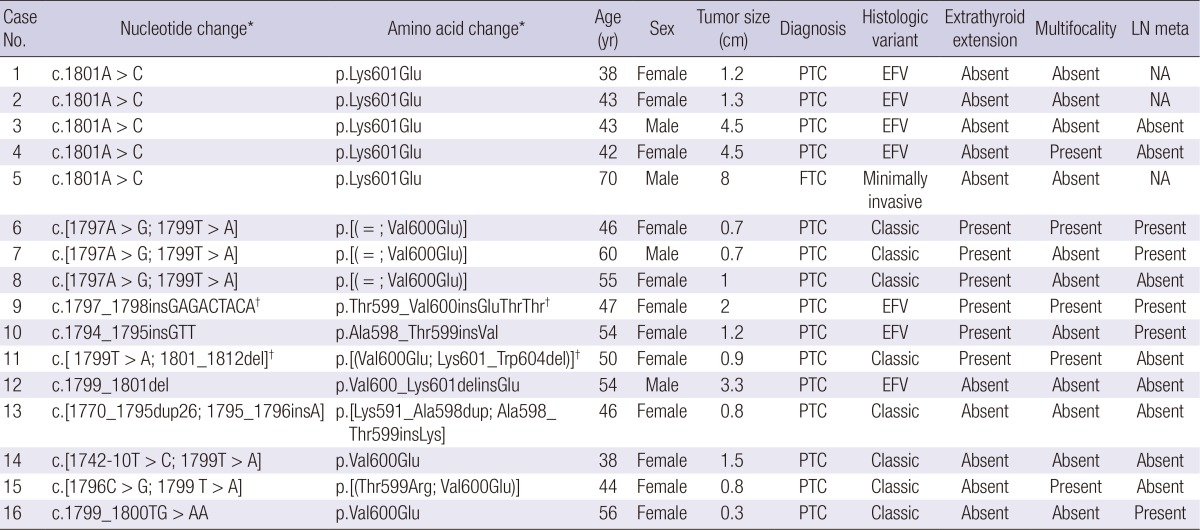
*Nomenclatures are assigned according to the system of the Human Genome Variation Society (www.hgvs.org/mutnomen); †These are novel complex mutations that have not been reported in thyroid cancer. PTC, papillary thyroid carcinoma; FTC, follicular thyroid carcinoma; EFV, encapsulated follicular variant; LN meta, lymph node metastasis.
We previously reported 3 novel complex mutations (cases 13, 14 and 15) and additionally found 2 novel BRAF mutations, c.1797_1798insGAGACTACA and c.[ 1799T>A; 1801_1812del] (case 9 and case 11, respectively). Sequence analysis of case 9 showed 9-nucleotide GAGACTACA insertion between positions c.1797 and c.1798 (c.1797_1798insGAGACTACA). This mutation leads to the insertion of 3 amino acids, glutamate-threonine-threonine, between codons 599 and 600 (p.Thr599_Val600insGluThrThr) (Fig. 1). The mutation in case 11 consisted of the usual T to A substitution at position c.1799 (c.1799T>A), followed by deletion of 12 nucleotides from c.1801 to c.1812. These mutations lead to a substitution from valine to glutamate at codon 600 and in-frame deletion of 4 amino acids from codons 601 to 604 (p.[(Val600Glu; Lys601_Trp604del)]) (Fig. 2). Cloning and subsequent sequence analysis of the PCR amplicon demonstrated that both mutations were located within the same allele.
Fig. 1.
Electropherograms of case 9 harboring a mutation of c.1797_1798insGAGACTACA. (A) Direct sequencing of BRAF exon 15 PCR product shows 9-bp tail sequence in its electropherograms. (B) Subcloning demonstrates newly inserted nucleotides (GAGACTACA) in between nucleotides positions c.1797 and c.1798.
Fig. 2.
Electropherograms of case 11, harboring a mutation of c.[1799T>A; 1801_1812del]. Direct sequencing shows a complex mutation of c.1799T>A and c.1801_1812del overlapped with the wild-type allele peaks (above). Deletion of 12 nucleotides (*AAATCTCGATGG) and, a substitution at nucleotide position c.1799 are located on the same allele. Subcloning reveals substitution and deletion mutations of the mutant clone, confirming that both mutations are located on the same allele (below).
Interestingly, a 61-yr-old female with medullary carcinomas at bilateral lobes showed BRAF c.1799T>A mutation (Fig. 3). The tumors were confirmed as pure medullary carcinomas based on the immunohistochemical findings of diffuse positivity for calcitonin, carcinoembryonic antigen and chromogranin (Fig. 3).
Fig. 3.
Histological and immunohistochemical aspects of the medullary thyroid carcinoma case (A, B) and electropherogram of its BRAF mutation (C). (A) The tumor shows a characteristic appearance with the presence of round to polygonal tumor cells with fibrosis and amyloid deposition (Hematoxylin and eosin stain, × 200). (B) Calcitonin immunohistochemical stain reveals diffuse and strong positivity in tumor cells (×200). (C) Forward electropherogram show overlapping peak at the nucleotide position c.1799. Mutant peak demonstrates a T to A transversion.
DISCUSSION
Our study summarizes data on 16 patients with rare mutations in BRAF, detected by direct sequencing of BRAF exon 15, in 2,763 thyroid cancer samples. Thus, 0.76% of BRAF-mutated tumors exhibited a rare mutation type.
Regarding the prevalence of mutation other than BRAF V600E, BRAF K601E was found the most common mutation, which is in agreement with a past report (1). The K601E mutation results from a substitution of A to G at the base position 1801 and has been reported to be associated with a FVPTC. In the FVPTC, the BRAF V600E mutation rate ranged from 9.6% to 26%, and the rate of BRAF K601E mutation has been reported to be as high as 9% (3, 4, 7). In our study, there were 4 cases of FVPTC harboring a BRAF K601E mutation. Another case, which was also mentioned in our previous report, was minimally invasive follicular carcinoma harboring the BRAF K601E mutation (2). Overall, the incidence of FVPTC with BRAF K601E mutation in Korea seems to be lower than incidences reported in Western countries (8). In our study, all 5 thyroid cancers with BRAF K601E showed less aggressive pathologic features (e.g., extrathyroidal extension and lymph node metastasis) compared with those harboring BRAF V600E. It is well known that there are 2 types of FVPTC: infiltrative and encapsulated forms. These forms show different clinical behaviors, and the presence of tumor capsule in the encapsulated follicular variant (EFV) is associated with excellent prognosis (4). All BRAF K601E-mutated tumors in our series belonged to EFV. Castro et al. (9) analyzed somatic mutation of 40 FVPTCs and found 3 cases harboring BRAF K601E. The tumors with BRAF K601E had no extrathyroidal extension, multifocality nor vascular invasion.
Penelli et al. (10) reported a case of follicular carcinoma with BRAF K601E and PIK3CA E545I mutations in a 78-yr-old male. The tumor showed capsular and multiple vascular invasions and a poorly differentiated component. Schulten et al. (11) reported the BRAF K601E in one case each from minimally invasive follicular carcinoma, classic PTC, and a follicular variant of PTC. We found a BRAF K601E in 70-yr-old male patient with an 8 cm-sized minimally invasive follicular carcinoma (Table 1, case 5). The tumor was composed of microfollicles and focally invaded the fibrous tumor capsule. No angioinvasion or extrathyroidal extension was found. These results suggest a link between BRAF K601E and follicular histology subtypes encompassing PTC and follicular carcinoma. BRAF mutation should be included as part of the molecular pathogenesis of follicular carcinoma although the mutation itself rarely occurs in the tumor.
Three classic PTCs were associated with nucleotide substitution at the base position 1797 and 1799, resulting in the common V600E mutation. The tumors were all less than 1 cm in size, but showed extrathyroidal extension. Among these cases, lymph node metastasis was found in 2 cases (Table 1).
In our series, one of 7 medullary carcinomas had the BRAF V600E genetic alteration. Hereditary medullary carcinoma, arising in multiple endocrine neoplasia type 2, harbored activating germ-line mutations of the RET proto-oncogene. Somatic RET mutations were detected in 46%-60% of sporadic medullary carcinomas, and somatic RAS mutations were also found in the tumors. However, BRAF mutation of medullary carcinoma has been reported only in a study by Goutas et al. (12). A Greek medullary carcinoma cohort of 44 patients analyzed BRAF status with an enriched PCR-restriction fragment length polymorphism method (PCR-RFLP) and found the BRAF V600E mutation in 30 samples (68.2%). One possible reason for such high frequency may be that the erroneous high mutation rate was made by the technical defect of PCR-RFLP method. PCR-RFLP utilizes restriction endonuclease for digestion of wild type and mutant type PCR productions. Therefore, when enzymatic activity is insufficient on the PCR products, false positive result may occur. In the sequencing analysis studies of large number of MTC samples (total 95 cases), no mutation of BRAF was found (13). However, the reason for such disparity remains to be clarified. In the present study, authenticity of the mutation was confirmed by repeat bidirectional DNA sequencing with the re-isolated genomic DNA using 2 different primer sets.
Table 2 summarizes rare exon 15 BRAF mutations previously reported in the literature with description of nucleotide changes. All rare BRAF mutations in thyroid cancers, except for the K601E, have been detected in PTC. Next to BRAF K601E mutation, 3-nucleotide (thymidine-guanine-adenine) deletions from the base positions 1799 to 1801 were found in 7 cases of PTC. This mutation results in deletion of 2 amino acids (p.Val600_Lys601) and insertion of glutamate. Interestingly, in one case studied by Oler et al. (14), the mutation was present exclusively in lymph node metastases. The authors suggested that it could be an additional cumulative genetic event in tumor progression or a result of metastasis from a different primary focus.
Table 2.
Clinicopathologic features of rare BRAF mutations of thyroid tumors previously reported in the literature
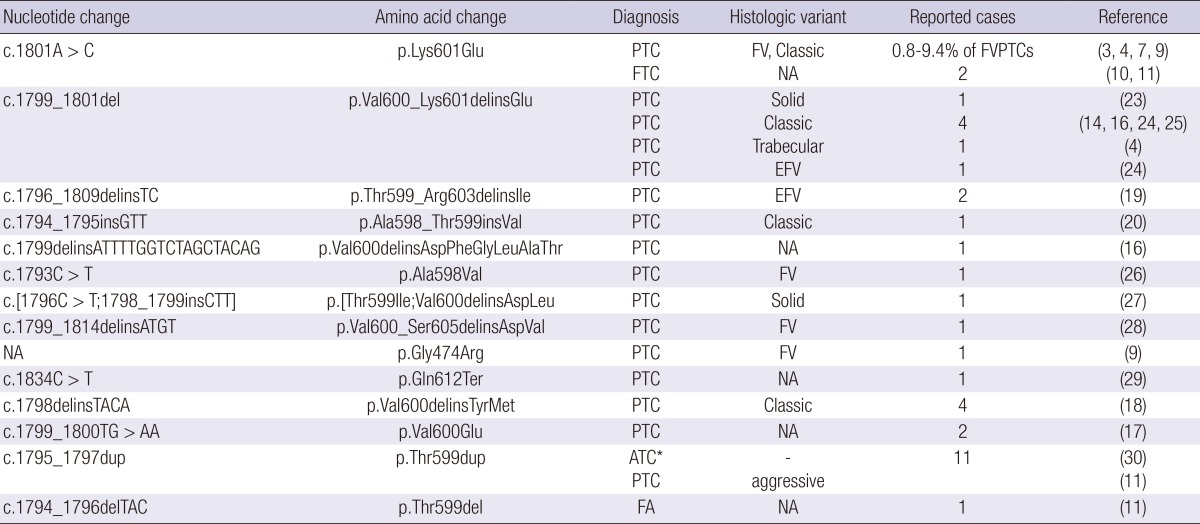
*The tumor was mixed ATC/PTC type. FV, follicular variant; PTC, papillary thyroid carcinoma; FTC, follicular thyroid carcinoma; EFV, encapsulated follicular variant; LN meta, lymph node metastasis; ATC, anaplastic thyroid carcinoma; NA, not available; FA, follicular adenoma.
BRAF is a serine-threonine kinase and is a part of MAPK signaling pathway. Once BRAF is translocated to the cell membrane and activated by RAS, it phosphorylates and activates MAPK pathway. This signaling pathway regulates various processes including cell proliferation, differentiation and survival (1). Oncogenic mutations of BRAF act by constitutive activation of MAPK pathway and they mostly affect residues located within the kinase domain of the protein; glycine-rich phosphate-binding loop (P loop, residues 462-471) and activation loop (A loop, residues 593-622). Activation of wild-type BRAF kinase needs phosphorylation of residues Thr599 and/or Ser602 which takes position in the activation segment. Under basal condition, hydrophobic interactions between A-loop and P-loop stabilize the protein. Oncogenic BRAF mutations of residue Val600 destabilize this inactive conformation, thereby triggering constitutive activation of the enzyme. Cancer-associated BRAF mutations can be divided into 3 categories according to their function. High kinase activity group (exemplified by V600E and K601E in A loop), low kinase activity group (exemplified by Gly464Glu in P loop and Phe595Leu in A loop), and rare impaired activity group (exemplified by Asp594Val in A loop). In the case of BRAF K601E, although it is in the high activity group, its kinase activity is 40% of that of BRAF V600E (15). Hou et al. (16) functionally characterized mutation caused by deletion and insertion (c.1799delins ATTTTGGTCTAGCTACAG). Like classical BRAF V600E, the new mutation resulted in constitutive activation of the kinase activity and also caused transformation of transfected cells (16). Several researchers also analyzed functional activity of the rare BRAF mutations, suggesting their important role in PTC tumorigenesis (17,18,19,20). These results support that the nucleotide sequence around position c.1799 is vulnerable to genetic alterations and disturbance of the electric charge in amino acid in this region converts BRAF into the oncogenic kinases (1).
There has been an association between BRAF V600E mutation and aggressive histologic characteristics of PTC, including extrathyroidal extension, lymph node metastasis, more advanced stage at the time of diagnosis and poor prognosis (4). Moreover, this mutation has been associated with a higher recurrence in low-risk stage I-II PTC patients (21). Although such results has not been found in some studies (7) and the conclusion is still a matter of debate, the clinical significance of the BRAF mutation in regard to tumor aggressiveness and as a poor prognostic factor is generally accepted. However, only a small number of cases have been reported regarding the clinicopathologic features of the rare BRAF mutations and further studies are needed to determine the significance of these mutations.
Less is known about the exact cause of PTC carcinogenesis, but one of the well-established risk factors is an ionizing radiation exposure. Among thyroid cancer mutation mechanisms, chromosomal rearrangements are strongly associated with ionizing radiation exposure (1). There have been only a few studies on the molecular epidemiology of thyroid cancer. According to a recent study, the increase in the incidence of thyroid cancer over the past 4 decades is strongly related to the increase in BRAF mutation in classic PTC and the increase in RAS mutation in FVPTC. In contrast, the frequency of thyroid cancer-specific chromosomal rearrangements is decreasing (22). Along with this general epidemiologic trend, the exceptionally high frequency of BRAF mutation in PTC of the Korean population implies that the recent increase in PTC incidence in Korea may be associated with the causes of BRAF mutation. There is some evidence supporting the role of environmental factors, including iodine diet and chemical influence, in BRAF mutagenesis (1), but further studies are still needed.
Direct sequencing is accepted as the gold standard method for the detection of genetic alterations and it can detect mutations at any gene position. However, other assay methods (e.g., pyrosequencing, colorimetric assay or shifted termination assay, real-time PCR, etc.) are mostly designed to detect point mutations in BRAF codon 600. The present study demonstrates that point mutations in codon 600 comprise more than 99% of all BRAF mutations. Based on this result, assay methods that screen for the "hot spot" BRAF c.1799T>A mutation seem to be reasonably sufficient for BRAF mutation screening in Korean thyroid cancer patients.
In conclusion, several BRAF mutation types other than BRAF V600E mutation exist but their prevalence is very low at around 0.76% among all BRAF mutation positive Korean thyroid cancers. BRAF K601E is the most common type of rare mutations. Although limited by the small number of BRAF K601E-mutated tumors, BRAF K601E may be associated with less aggressive pathologic features, when taken together with previous reports. We add 2 novel mutations to the list of BRAF mutations found in PTC. Further studies are needed to characterize the roles of rare BRAF mutations in thyroid cancers.
Footnotes
Funding: This research was supported by the Basic Science Research Program through the National Research Foundation of Korea (NRF) funded by the Ministry of Science, ICT and Future Planning (2013R1A2A2A01068570).
The authors declare that no competing financial interests exist.
References
- 1.Nikiforov YE, Nikiforova MN. Molecular genetics and diagnosis of thyroid cancer. Nat Rev Endocrinol. 2011;7:569–580. doi: 10.1038/nrendo.2011.142. [DOI] [PubMed] [Google Scholar]
- 2.Jung CK, Im SY, Kang YJ, Lee H, Jung ES, Kang CS, Bae JS, Choi YJ. Mutational patterns and novel mutations of the BRAF gene in a large cohort of Korean patients with papillary thyroid carcinoma. Thyroid. 2012;22:791–797. doi: 10.1089/thy.2011.0123. [DOI] [PubMed] [Google Scholar]
- 3.Trovisco V, Vieira de Castro I, Soares P, Máximo V, Silva P, Magalhães J, Abrosimov A, Guiu XM, Sobrinho-Simões M. BRAF mutations are associated with some histological types of papillary thyroid carcinoma. J Pathol. 2004;202:247–251. doi: 10.1002/path.1511. [DOI] [PubMed] [Google Scholar]
- 4.Lupi C, Giannini R, Ugolini C, Proietti A, Berti P, Minuto M, Materazzi G, Elisei R, Santoro M, Miccoli P, et al. Association of BRAF V600E mutation with poor clinicopathological outcomes in 500 consecutive cases of papillary thyroid carcinoma. J Clin Endocrinol Metab. 2007;92:4085–4090. doi: 10.1210/jc.2007-1179. [DOI] [PubMed] [Google Scholar]
- 5.Lima J, Trovisco V, Soares P, Máximo V, Magalhães J, Salvatore G, Santoro M, Bogdanova T, Tronko M, Abrosimov A, et al. BRAF mutations are not a major event in post-Chernobyl childhood thyroid carcinomas. J Clin Endocrinol Metab. 2004;89:4267–4271. doi: 10.1210/jc.2003-032224. [DOI] [PubMed] [Google Scholar]
- 6.Den Dunnen JT, Antonarakis SE. Mutation nomenclature extensions and suggestions to describe complex mutations: a discussion. Hum Mutat. 2000;15:7–12. doi: 10.1002/(SICI)1098-1004(200001)15:1<7::AID-HUMU4>3.0.CO;2-N. [DOI] [PubMed] [Google Scholar]
- 7.Trovisco V, Soares P, Preto A, de Castro IV, Lima J, Castro P, Máximo V, Botelho T, Moreira S, Meireles AM, et al. Type and prevalence of BRAF mutations are closely associated with papillary thyroid carcinoma histotype and patients' age but not with tumour aggressiveness. Virchows Arch. 2005;446:589–595. doi: 10.1007/s00428-005-1236-0. [DOI] [PubMed] [Google Scholar]
- 8.Kim WY, Ko YS, Hwang TS, Han HS, Lim SD, Kim WS, Oh SY. A case of multifocal papillary thyroid carcinoma consisting of one encapsulated follicular variant with BRAF K601E mutation and three conventional types with BRAF V600E mutation. Korean J Pathol. 2013;47:293–298. doi: 10.4132/KoreanJPathol.2013.47.3.293. [DOI] [PMC free article] [PubMed] [Google Scholar]
- 9.Castro P, Rebocho AP, Soares RJ, Magalhães J, Roque L, Trovisco V, Vieira de, Cardoso-de-Oliveira M, Fonseca E, Soares P, et al. PAX8-PPARgamma rearrangement is frequently detected in the follicular variant of papillary thyroid carcinoma. J Clin Endocrinol Metab. 2006;91:213–220. doi: 10.1210/jc.2005-1336. [DOI] [PubMed] [Google Scholar]
- 10.Pennelli G, Vianello F, Barollo S, Pezzani R, Merante Boschin I, Pelizzo MR, Mantero F, Rugge M, Mian C. BRAF(K601E) mutation in a patient with a follicular thyroid carcinoma. Thyroid. 2011;21:1393–1396. doi: 10.1089/thy.2011.0120. [DOI] [PubMed] [Google Scholar]
- 11.Schulten HJ, Salama S, Al-Mansouri Z, Alotibi R, Al-Ghamdi K, Al-Hamour OA, Sayadi H, Al-Aradati H, Al-Johari A, Huwait E, et al. BRAF mutations in thyroid tumors from an ethnically diverse group. Hered Cancer Clin Pract. 2012;10:10. doi: 10.1186/1897-4287-10-10. [DOI] [PMC free article] [PubMed] [Google Scholar]
- 12.Goutas N, Vlachodimitropoulos D, Bouka M, Lazaris AC, Nasioulas G, Gazouli M. BRAF and K-RAS mutation in a Greek papillary and medullary thyroid carcinoma cohort. Anticancer Res. 2008;28:305–308. [PubMed] [Google Scholar]
- 13.Cerrato A, De Falco V, Santoro M. Molecular genetics of medullary thyroid carcinoma: the quest for novel therapeutic targets. J Mol Endocrinol. 2009;43:143–155. doi: 10.1677/JME-09-0024. [DOI] [PubMed] [Google Scholar]
- 14.Oler G, Ebina KN, Michaluart P, Jr, Kimura ET, Cerutti J. Investigation of BRAF mutation in a series of papillary thyroid carcinoma and matched-lymph node metastasis reveals a new mutation in metastasis. Clin Endocrinol (Oxf) 2005;62:509–511. doi: 10.1111/j.1365-2265.2005.02235.x. [DOI] [PubMed] [Google Scholar]
- 15.Wan PT, Garnett MJ, Roe SM, Lee S, Niculescu-Duvaz D, Good VM, Jones CM, Marshall CJ, Springer CJ, Barford D, et al. Mechanism of activation of the RAF-ERK signaling pathway by oncogenic mutations of B-RAF. Cell. 2004;116:855–867. doi: 10.1016/s0092-8674(04)00215-6. [DOI] [PubMed] [Google Scholar]
- 16.Hou P, Liu D, Xing M. Functional characterization of the T1799-1801del and A1799-1816ins BRAF mutations in papillary thyroid cancer. Cell Cycle. 2007;6:377–379. doi: 10.4161/cc.6.3.3818. [DOI] [PubMed] [Google Scholar]
- 17.Di Cristofaro J, Silvy M, Lanteaume A, Marcy M, Carayon P, De Micco C. Expression of tpo mRNA in thyroid tumors: quantitative PCR analysis and correlation with alterations of ret, Braf, ras and pax8 genes. Endocr Relat Cancer. 2006;13:485–495. doi: 10.1677/erc.1.01164. [DOI] [PubMed] [Google Scholar]
- 18.Matsuse M, Mitsutake N, Tanimura S, Ogi T, Nishihara E, Hirokawa M, Fuziwara CS, Saenko VA, Suzuki K, Miyauchi A, et al. Functional characterization of the novel BRAF complex mutation, BRAF (V600delinsYM), identified in papillary thyroid carcinoma. Int J Cancer. 2013;132:738–743. doi: 10.1002/ijc.27709. [DOI] [PubMed] [Google Scholar]
- 19.De Falco V, Giannini R, Tamburrino A, Ugolini C, Lupi C, Puxeddu E, Santoro M, Basolo F. Functional characterization of the novel T599I-VKSRdel BRAF mutation in a follicular variant papillary thyroid carcinoma. J Clin Endocrinol Metab. 2008;93:4398–4402. doi: 10.1210/jc.2008-0887. [DOI] [PubMed] [Google Scholar]
- 20.Moretti S, Macchiarulo A, De Falco V, Avenia N, Barbi F, Carta C, Cavaliere A, Melillo RM, Passeri L, Santeusanio F, et al. Biochemical and molecular characterization of the novel BRAF (V599Ins) mutation detected in a classic papillary thyroid carcinoma. Oncogene. 2006;25:4235–4240. doi: 10.1038/sj.onc.1209448. [DOI] [PubMed] [Google Scholar]
- 21.Kim TY, Kim WB, Rhee YS, Song JY, Kim JM, Gong G, Lee S, Kim SY, Kim SC, Hong SJ, et al. The BRAF mutation is useful for prediction of clinical recurrence in low-risk patients with conventional papillary thyroid carcinoma. Clin Endocrinol (Oxf) 2006;65:364–368. doi: 10.1111/j.1365-2265.2006.02605.x. [DOI] [PubMed] [Google Scholar]
- 22.Jung CK, Little MP, Lubin JH, Brenner AV, Wells SA, Jr, Sigurdson AJ, Nikiforov YE. The increase in thyroid cancer incidence during the last four decades is accompanied by a high frequency of BRAF mutations and a sharp increase in RAS mutations. J Clin Endocrinol Metab. 2014;99:E276–E285. doi: 10.1210/jc.2013-2503. [DOI] [PMC free article] [PubMed] [Google Scholar]
- 23.Trovisco V, Soares P, Soares R, Magalhães J, Sá-Couto P, Sobrinho-Simões M. A new BRAF gene mutation detected in a case of a solid variant of papillary thyroid carcinoma. Hum Pathol. 2005;36:694–697. doi: 10.1016/j.humpath.2005.04.011. [DOI] [PubMed] [Google Scholar]
- 24.Lee SR, Jung CK, Kim TE, Bae JS, Jung SL, Choi YJ, Kang CS. Molecular genotyping of follicular variant of papillary thyroid carcinoma correlates with diagnostic category of fine-needle aspiration cytology: values of RAS mutation testing. Thyroid. 2013;23:1416–1422. doi: 10.1089/thy.2012.0640. [DOI] [PMC free article] [PubMed] [Google Scholar]
- 25.Jang MA, Lee ST, Oh YL, Kim SW, Chung JH, Ki CS, Kim JW. Identification of a rare 3 bp BRAF gene deletion in a thyroid nodule by mutant enrichment with 3'-modified oligonucleotides polymerase chain reaction. Ann Lab Med. 2012;32:238–241. doi: 10.3343/alm.2012.32.3.238. [DOI] [PMC free article] [PubMed] [Google Scholar]
- 26.Santarpia L, Sherman SI, Marabotti A, Clayman GL, El-Naggar AK. Detection and molecular characterization of a novel BRAF activated domain mutation in follicular variant of papillary thyroid carcinoma. Hum Pathol. 2009;40:827–833. doi: 10.1016/j.humpath.2008.11.003. [DOI] [PubMed] [Google Scholar]
- 27.Chiosea S, Nikiforova M, Zuo H, Ogilvie J, Gandhi M, Seethala RR, Ohori NP, Nikiforov Y. A novel complex BRAF mutation detected in a solid variant of papillary thyroid carcinoma. Endocr Pathol. 2009;20:122–126. doi: 10.1007/s12022-009-9073-3. [DOI] [PubMed] [Google Scholar]
- 28.Barzon L, Masi G, Boschin IM, Lavezzo E, Pacenti M, Casal Ide E, Toniato A, Toppo S, Palù G, Pelizzo MR. Characterization of a novel complex BRAF mutation in a follicular variant papillary thyroid carcinoma. Eur J Endocrinol. 2008;159:77–80. doi: 10.1530/EJE-08-0239. [DOI] [PubMed] [Google Scholar]
- 29.Trovisco V, Couto JP, Cameselle-Teijeiro J, de Castro IV, Fonseca E, Soares P, Sobrinho-Simões M. Acquisition of BRAF gene mutations is not a requirement for nodal metastasis of papillary thyroid carcinoma. Clin Endocrinol (Oxf) 2008;69:683–685. doi: 10.1111/j.1365-2265.2008.03243.x. [DOI] [PubMed] [Google Scholar]
- 30.Gauchotte G, Philippe C, Lacomme S, Léotard B, Wissler MP, Allou L, Toussaint B, Klein M, Vignaud JM, Bressenot A. BRAF, p53 and SOX2 in anaplastic thyroid carcinoma: evidence for multistep carcinogenesis. Pathology. 2011;43:447–452. doi: 10.1097/PAT.0b013e3283486178. [DOI] [PubMed] [Google Scholar]



